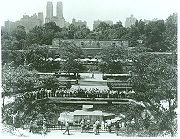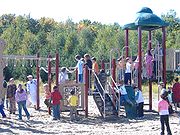From The Peopling of New York City
Contents |
The History of Parks
By:Sophie Chen
Parks are commonly known as specific places for people to bring their children to play, walk their dogs, and participate in athletic games. But what is less commonly known is the reason for their existence in urban settings and cities. Here we will explore: the purpose of parks in urban settings, how parks have changed over time, parks as a method of social reform, and park’s relationship to immigrants today.
Purpose
During the nineteenth century, empty spaces were created into parks because there was a demand to balance the stress and vices that came with industrialization, urbanization, and commercialization. Park advocates have linked the accommodations and needs for parks with the attempt to solve and/or ameliorate urban problems. These vices/urban problems that were considered to be increasingly problematic in cities at the time include: “alcoholism, prostitution, psychological degeneration due to lack of exercise, disease, delinquency, and the absence of shared civic order." (Women in Urban Parks) [1]
Park Development
1. Pleasure Ground (1850-1900) was described as “an antidote to the ills of rapidly industrialized city, visually and programmatically its antithesis, with a curving, picturesque landscape and emphasis on mental refreshment.” During this time reformers/park advocates wanted a respectable setting where a man could appear in public with his wife and children. This setting would allow the man to recognize his role in the family as the head of the household. According to Charles Eliot, park advocate and president of Harvard University (at the time this article was written in 1980 - confusing; just: this article was written in 1980? -- Amrita), parks were supposed to promote and encourage “a high standard of family life” because as he reasoned, “the pleasures men share with their wives and children are apt to be safer pleasures than those they take by themselves.” So men who would frequent parks with their families would be less encouraged and tempted to indulge into the very vices that come from the stress of a nine to five job in the city, especially at a time when industrialization and commercialization was booming. Because urban settings are of a different pace and lifestyle than suburban and rural settings, reformers/park advocates wanted to include a place devoted to nature to offset the unnatural vices of urbanization.
2. Reform Park (1900-1930) made parks accessible to the working class. In the previous model, the pleasure ground was only made accessible to middle-class families (who at the time attended parks frequently). Working class families wanted a place for their children to enjoy as well, but because parks were located at a costly distance they were originally excluded from these "wholesome recreational opportunities." Park advocates at this time also promoted playgrounds in parks because physical exercise in safe setting (rather than street) was crucial. Also it may be noted that in the previous model, parks did not have playgrounds because park advocates at the time assumed that children would be entertained by their mothers.
3. Recreation Facility (1930-1965) is a period that recognized parks as a functioning part of cities, along with schools, post offices, hospitals, etc. During this time park advocates reverted back to the motivation of promoting family togetherness. The idea was that “Mom, Pop and the kids must do things as a group.” So programs and facilities were created with the family in mind. This is also when athletic leagues were being organized in parks, which included sports such as: softball, tennis, table tennis, basketball, and golf. Recreational activities included: folk dancing, field days, picnics, and festivals.
4. Open-Space System (1965-Present) is when there is a new attitude towards the perception of the usefulness of open space, that it was valuable wherever found (Awkward sentence -- Amrita). The central goal during this time was to help revitalize the inner city: visually, economically, and socially. Park planners went against previous traditional standards of size, shape, topography, and location of parks. During the 1960s, there was stress placed on riot control, which meant that park advocates/reformers were targeting their youth population. Therefore parks began to implement cultural programs which included, concerts, dances, celebrations, etc. Park advocates also wanted to appeal to the middle-class where their design was focused on providing a “safe and attractive” environment for “the businessmen and women on their lunch breaks from downtown offices-and the upper-middle-class suburban shoppers.”
Social Reform
There are four virtues to which (that? -- Amrita) parks wanted to promote in society, which include: public health and prosperity, normative concerns for social coherence and democratic equality. (Adapted from Modern Urban Parks) [2]
- Health: Providing a safe and respectable place for people to engage in athletics.
- Prosperity: Parks provide a safe environment for children and youth, which trickles down to reduce costs for the police and justice systems. And because parks were promoting the development of “responsible and involved citizen[s],” they are contributing to society by fostering these attitudes.
- Social Coherence: Providing a place for youth to play and grow amongst their peers deters juvenile crime because they are exposed to social experiences early. Since the implementation of playgrounds allows children to play amongst children of all ages and races, they also learn to cooperate with one another at an earlier age.
- Democratic Equality: Parks provide a place for a diverse group of people to cooperate and compete athletically with one another locally.
Parks and Immigrants in New York City
History shows that parks are constantly being changed or expanded to accommodate changes in society’s taste and needs. Park planners are now concerned with a new group of people in urban settings who are frequent park users, immigrants. In New York City parks especially, it is no surprise to see many faces of people from all over the world in one place, enjoying each others company, whether in athletics or simple conversation. Parks are also a place to implement immigrant children into social groups because that is one of the very crucial places where they learn from children who are like and unlike them, which also prepares them for cooperation with peers in schools. (In addition, -- Amrita) immigrant parents have an outlet for them to relax after a strenuous and stressful day/week at work. Currently the main accommodation necessary for immigrants is to provide recreational programs available and accessible to them in languages other than English. As we have seen with the parks we are concerned with in our wiki, some accommodations have been made according to the tastes of the immigrants. For example, the cricket fields in Kissena Park. With the rising popularity of cricket, it is no surprise to see more cricket fields in New York City. In Columbus Park, there are tables specific for Asian men to play Chinese Chess and Asian women to play cards. These accommodations are necessary because parks provide a place for immigrants to mingle with people who are like them and who are unlike them,(-which -- delete; Amrita) ultimately eases(easing--Amrita) their transition from life back home in the old country to life here in New York City. --Sophie Chen 01:08, 5 May 2010 (UTC)
Demographic of the Chess Players
The Chinese Chess players are mostly middle age or older men. There aren't women playing chess in the park, most of the women are there for the card games. The reason for lack of female players is that chess is portrayed as a guy's sport in the culture. In addition, Chinese Chess is associated with military tactics; the game itself is believed, by a population of players (including my father), to be created by a Han Xin, military tactician in the Han Dynasty. In many cultures, women are not related with the military; they were taught to avoid non-feminine activities. That is a possible reason for the game's lack of popularity with females. But of course, there are a number of female professional Chess players who had made their names known.
The majority of the Chess players are immigrants. Chinese Chess is an important member of traditional Chinese activities. Many male Chinese-Borns know more or less about the rules of the game. Most immigrants who are playing chess learned to play it in their childhoods. According to the impressions of the interviewees, most ABC's (American-Born Chinese) do not play the game or do not play it in the park. However, occasionally there will be American-Borns who are enthusiastic about learning. An interviewee recalled that there were about 20 young kids who were trying to learn about the game. Interestingly, sometimes young people would bring their laptops to the park and play Chess with it.
Non-Chinese players rarely show up in the park for the games. The language barrier is an issue for players from other nations. Interviewees reported that sometimes white people would come to the park and observe the game. Currently, there is a white woman who would come to the park on Saturday and Sundays to observe the games; she's serious enough to record the moves. Our interviewee also told us that on rare occasions, there would be Koreans or Japanese players in the park. Those players were able to play in the park because they spoke some Chinese. Seems like overcoming the language barrier is necessary for Non-Chinese players to participate in this activity.
Anna-Sofiya Lupolover
The following is a helpful PDF that has statistics of foreign born New Yorkers in parks, along with other interesting information by New Yorkers for Parks.
[www.ny4p.org/pdfs/Immigration_Report_vF_web.pdf]

